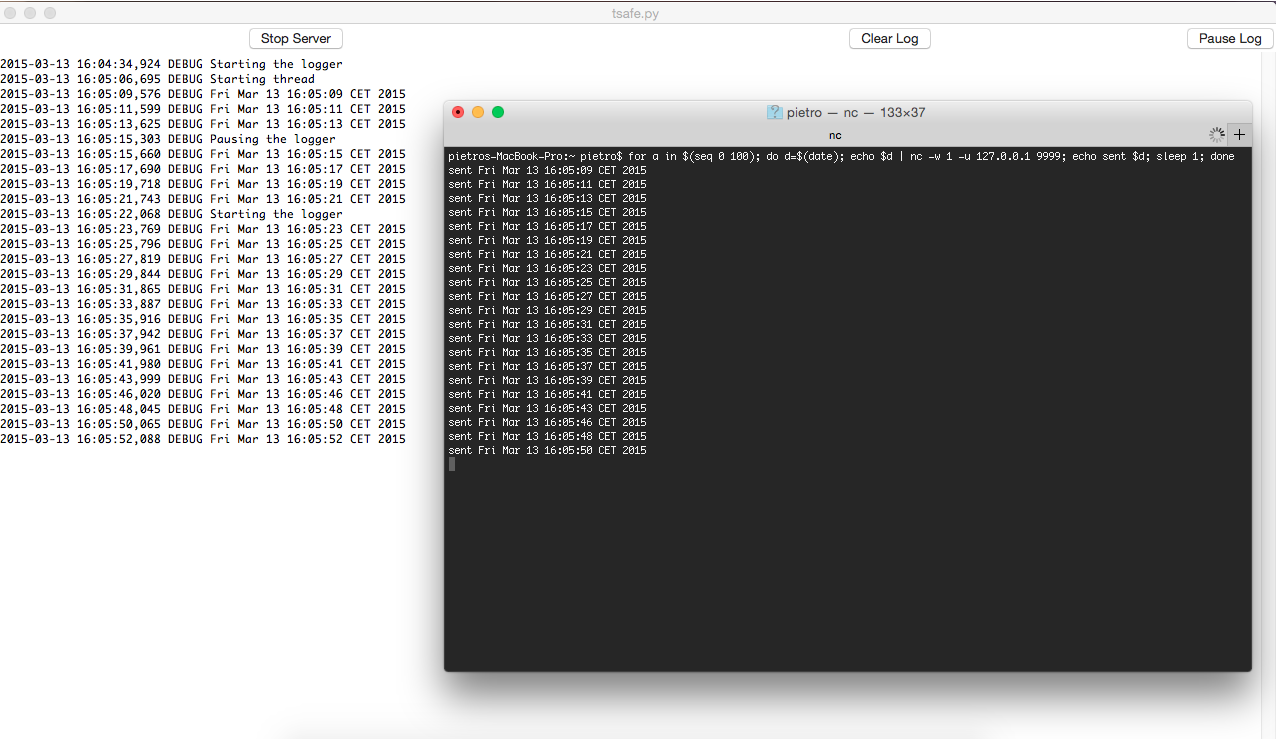A server launcher with log console in Python Tkinter
Posted on Fri 13 March 2015 in Python
I'm working on an Tk application that should start and stop an UDP server, I need to show server logs in the Tk GUI with a "Pause & Resume" button.
I already have the UDP server implemented using the blocking SocketServer.BaseRequestHandler , so in order to wrap a GUI to the server I need to run the server in a separate Thread.
My server already logs all messages using the Python logging module, this StackExchange snipped shows a good example of how to write on a Text widget from the logging Python module.
Soon I found that Python Tkinter and multithreading is a frequent cause of headache.
The secret for avoiding a big waste of debugging hours is to keep away from all the graphical things child threads. In brief a child thread cannot interact with Tk, otherwise your application is at risk of deadlock or race conditions.
So I found the solution to write from the logging handler in a Python Queue, the Tk widget will read and display the Queue contents using a recursive after callback.
Here the code:
# Copyright 2015 Pietro Bertera \<pietro@bertera.it\>
#
# This program is free software: you can redistribute it and/or modify
# it under the terms of the GNU General Public License as published by
# the Free Software Foundation, either version 3 of the License, or
# (at your option) any later version.
#
# This program is distributed in the hope that it will be useful,
# but WITHOUT ANY WARRANTY; without even the implied warranty of
# MERCHANTABILITY or FITNESS FOR A PARTICULAR PURPOSE. See the
# GNU General Public License for more details.
#
# You should have received a copy of the GNU General Public License
# along with this program. If not, see http://www.gnu.org/licenses/
import Queue
import SocketServer
import socket
import sys
import logging
import threading
import Tkinter as tk
from ScrolledText import ScrolledText
class QueueLogger(logging.Handler):
def __init__(self, queue):
logging.Handler.__init__(self)
self.queue = queue
# write in the queue
def emit(self, record):
self.queue.put(self.format(record).rstrip('\n') + '\n')
class LoggedUDPServer(SocketServer.ThreadingMixIn, SocketServer.UDPServer):
def __init__(self, server_address, RequestHandlerClass, logger):
SocketServer.UDPServer.__init__(self, server_address, RequestHandlerClass)
# Add the queue logger
self.logger = logger
class UDPHandler(SocketServer.BaseRequestHandler):
def handle(self):
# Queue logger is un under the self.server object
self.server.logger.debug(self.request[0])
class MainApplication:
def __init__(self, root, log_level, ip, port ):
self.root = root
self.log_level = log_level
self.ip = ip
self.port = port
self.root.columnconfigure(0, weight=1)
self.root.rowconfigure(0, weight=1)
# 2 rows: firts with settings, second with registrar data
self.main_frame = tk.Frame(self.root)
# Commands row doesn't expands
self.main_frame.rowconfigure(0, weight=0)
# Logs row will grow
self.main_frame.rowconfigure(1, weight=1)
# Main fram can enlarge
self.main_frame.columnconfigure(0, weight=1)
self.main_frame.columnconfigure(1, weight=1)
self.main_frame.grid(row=0, column=0, sticky=tk.NSEW)
# Run/Stop button
self.control_button = tk.Button(self.main_frame, text="Run Server", command=self.run_server)
self.control_button.grid(row=0, column=0, sticky=tk.N)
# Clear button
self.clear_button = tk.Button(self.main_frame, text="Clear Log", command=self.clear_log)
self.clear_button.grid(row=0, column=1, sticky=tk.N)
# Stop log button
self.control_log_button = tk.Button(self.main_frame, text="Pause Log", command=self.stop_log)
self.control_log_button.grid(row=0, column=2, sticky=tk.N)
# Logs Widget
self.log_widget = ScrolledText(self.main_frame)
self.log_widget.grid(row=1, column=0, columnspan=3, sticky=tk.NSEW)
# Not editable
self.log_widget.config(state='disabled')
# Queue where the logging handler will write
self.log_queue = Queue.Queue()
# Stup the logger
l = logging.getLogger('logger')
l.setLevel(self.log_level)
formatter = logging.Formatter('%(asctime)s %(levelname)s %(message)s')
# Use the QueueLogger as Handler
hl = QueueLogger(queue=self.log_queue)
hl.setFormatter(formatter)
l.addHandler(hl)
self.logger = logging.getLogger('logger')
# Setup the update_widget callback reading logs from the queue
self.start_log()
def stop_log(self):
self.logger.debug("Pausing the logger")
if self.logger_alarm is not None:
self.log_widget.after_cancel(self.logger_alarm)
self.control_log_button.configure(text="Start Log", command=self.start_log)
self.logger_alarm = None
def start_log(self):
self.logger.debug("Starting the logger")
self.update_widget(self.log_widget, self.log_queue)
self.control_log_button.configure(text="Pause Log", command=self.stop_log)
def update_widget(self, widget, queue):
widget.config(state='normal')
# Read from the Queue and add to the log widger
while not queue.empty():
line = queue.get()
widget.insert(tk.END, line)
widget.see(tk.END) # Scroll to the bottom
widget.update_idletasks()
widget.config(state='disabled')
self.logger_alarm = widget.after(10, self.update_widget, widget, queue)
def clear_log(self):
self.log_widget.config(state='normal')
self.log_widget.delete(0.0, tk.END)
self.log_widget.config(state='disabled')
def run_server(self):
self.logger.debug("Starting thread")
try:
self.server = LoggedUDPServer((self.ip, self.port), UDPHandler, self.logger)
self.server_thread = threading.Thread(name='server', target=self.server.serve_forever)
self.server_thread.daemon = True
self.server_thread.start()
self.control_button.configure(text="Stop Server", command=self.stop_server)
except Exception, e:
self.logger.error("Cannot start the server: %s" % e)
raise e
def stop_server(self):
self.logger.debug("Stopping server")
self.server.shutdown()
self.server.socket.close()
self.logger.debug("Server stopped")
self.control_button.configure(text="Run Server", command=self.run_server)
if __name__ == "__main__":
root = tk.Tk()
if len(sys.argv) == 3:
port = int(sys.argv[2])
address = sys.argv[1]
app = MainApplication(root, logging.DEBUG, address, port)
root.title(sys.argv[0])
root.mainloop()
else:
print "Error: you must specify address and port.."
sys.exit(-1)
Here a screenshot of the UDP server in action:
